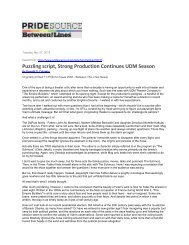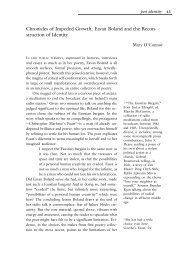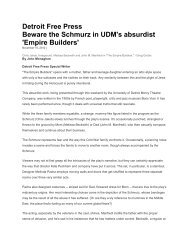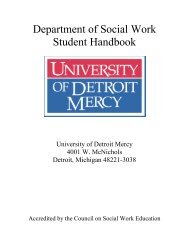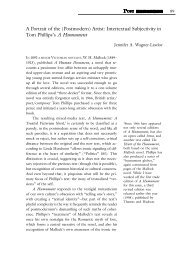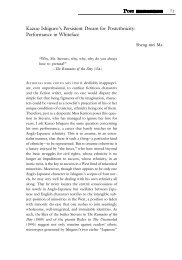Conquest, Conversion, and the Hybrid Self in Cabeza de Vaca's ...
Conquest, Conversion, and the Hybrid Self in Cabeza de Vaca's ...
Conquest, Conversion, and the Hybrid Self in Cabeza de Vaca's ...
You also want an ePaper? Increase the reach of your titles
YUMPU automatically turns print PDFs into web optimized ePapers that Google loves.
126 POST OST IDENTITY<br />
IDENTITY<br />
3 The first Spanish edition<br />
of La Relación was<br />
published <strong>in</strong> 1542 with <strong>the</strong><br />
title La relacion que dio<br />
Aluar nuñez cabeça <strong>de</strong><br />
vaca <strong>de</strong> lo acaescido en las<br />
Indias en la armada don<strong>de</strong><br />
yua por gouernador<br />
Páphilo <strong>de</strong> narbaez <strong>de</strong>s<strong>de</strong> el<br />
año <strong>de</strong> veynte y siete hasta<br />
el año <strong>de</strong> treynta y seys que<br />
boluio a Seuilla con tres <strong>de</strong><br />
su compañia. The next<br />
Spanish edition was<br />
published <strong>in</strong> 1555. For<br />
this essay, I have used <strong>the</strong><br />
first English translation by<br />
Buck<strong>in</strong>gham Smith <strong>and</strong> all<br />
references <strong>in</strong> <strong>the</strong> essay<br />
come from this text. For<br />
o<strong>the</strong>r English translations,<br />
see B<strong>and</strong>elier, Covey,<br />
Favata <strong>and</strong> Fernán<strong>de</strong>z,<br />
has to balance multiple i<strong>de</strong>ntities with<strong>in</strong> a nascent<br />
“Indianized” European self. This transformation m<strong>in</strong>imally<br />
presents two central challenges to <strong>the</strong> i<strong>de</strong>ntity <strong>and</strong> function<br />
of <strong>the</strong> colonizer <strong>in</strong> <strong>the</strong> New World: How can <strong>the</strong> newly<br />
formed ethnographer-self situate his cultural relativism both<br />
with <strong>the</strong> discoverer-self who was more concerned with conquest<br />
<strong>and</strong> subjectification of <strong>the</strong> natives <strong>and</strong> <strong>the</strong> missionary-self<br />
whose reduction of ethnocentrism <strong>and</strong> <strong>the</strong> conquest<br />
motive serves only to streng<strong>the</strong>n his <strong>de</strong>sire to Christianize<br />
<strong>the</strong> O<strong>the</strong>r? And if <strong>the</strong> hybridized colonizer assimilates<br />
<strong>in</strong>to native culture <strong>and</strong> views <strong>the</strong> <strong>in</strong>digenous population<br />
not as “evil” or “diabolical,” <strong>the</strong>n what happens to<br />
<strong>the</strong> coloniz<strong>in</strong>g impulse?<br />
Before he becomes an ethnographer, <strong>Cabeza</strong> <strong>de</strong> Vaca<br />
possesses all of <strong>the</strong> Eurocentric <strong>and</strong> racist attitu<strong>de</strong>s of his<br />
contemporaries. While he does on occasion note <strong>the</strong> positive<br />
physical attributes of <strong>the</strong> natives, “admirable proportions,<br />
very spare <strong>and</strong> of great activity <strong>and</strong> strength,” <strong>and</strong><br />
comments on <strong>the</strong>ir physical prowess, “<strong>the</strong> power <strong>and</strong> skill”<br />
with which <strong>the</strong>y can shoot <strong>the</strong>ir arrows, he never<strong>the</strong>less<br />
sees <strong>the</strong>m as strange, someth<strong>in</strong>g less than, or perhaps more<br />
than human, creatures who are “naked” <strong>and</strong> “large of body”<br />
<strong>and</strong> who “appear at a distance like giants” (39). 3 He is also<br />
unable or unwill<strong>in</strong>g to comprehend features of <strong>the</strong>ir culture<br />
such as ritual burial. Dur<strong>in</strong>g his sojourn along <strong>the</strong><br />
west coast of Florida, he <strong>and</strong> his party see a number of<br />
cases “<strong>in</strong> each of <strong>the</strong>m a <strong>de</strong>ad man” with <strong>the</strong> bodies “covered<br />
with pa<strong>in</strong>ted <strong>de</strong>er sk<strong>in</strong>s.” They believe, as <strong>Cabeza</strong> <strong>de</strong><br />
Vaca expla<strong>in</strong>s, that this is some “k<strong>in</strong>d of idolatry” <strong>and</strong> so<br />
<strong>the</strong> Commissary or<strong>de</strong>rs <strong>the</strong> cases <strong>and</strong> bodies burned (24).<br />
<strong>Cabeza</strong> <strong>de</strong> Vaca also cannot un<strong>de</strong>rst<strong>and</strong> why his party is<br />
met with such hostility along <strong>the</strong> Florida coast. Despite<br />
captur<strong>in</strong>g, enslav<strong>in</strong>g, <strong>and</strong> kill<strong>in</strong>g some of <strong>the</strong> natives, as<br />
well as <strong>de</strong>stroy<strong>in</strong>g <strong>the</strong>ir property, he f<strong>in</strong>ds a Native American<br />
attack most surpris<strong>in</strong>g, for <strong>the</strong>y “fell sud<strong>de</strong>nly upon<br />
us,” both on his lea<strong>de</strong>r’s party <strong>and</strong> even those “who were<br />
very sick, scattered along <strong>the</strong> shore.” The fierce attack—<br />
three times dur<strong>in</strong>g <strong>the</strong> night <strong>in</strong> which <strong>Cabeza</strong> <strong>de</strong> Vaca himself<br />
was “woun<strong>de</strong>d <strong>in</strong> <strong>the</strong> face”—does not <strong>in</strong>dicate to <strong>the</strong>m<br />
that <strong>the</strong>y should leave <strong>the</strong> area (53–4). It merely signals <strong>the</strong><br />
uncivilized brutality of pagans who have no regard for<br />
Alan J. Silva




